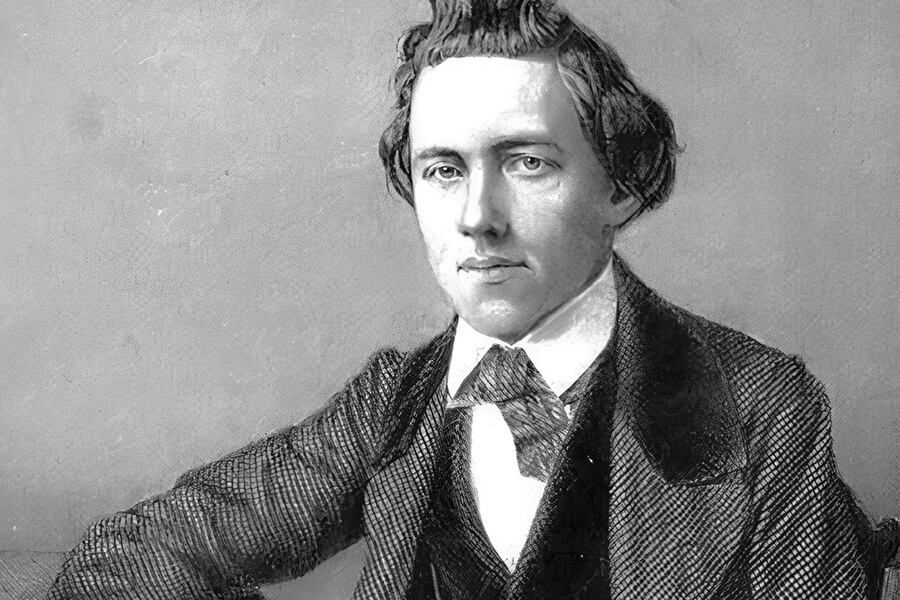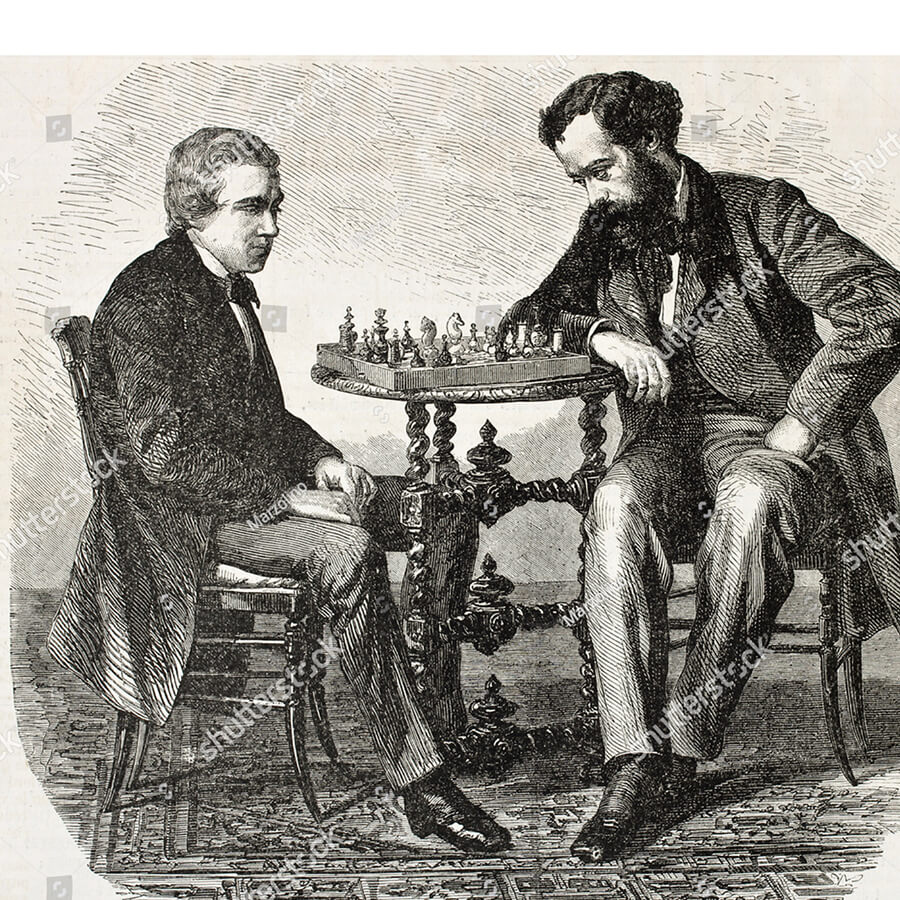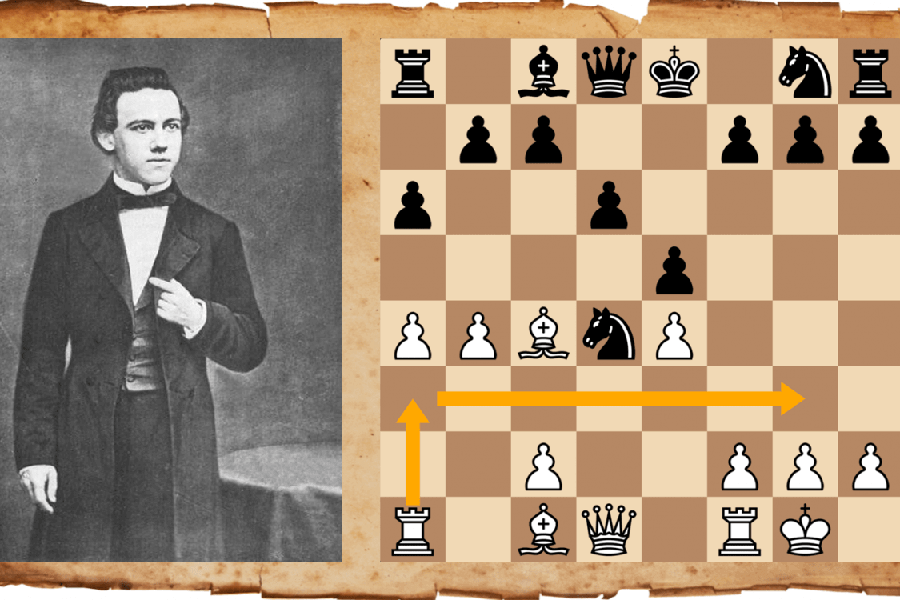No products in the cart.
Chess Players
Paul Morphy | Top 10 American Chess Players
Table of Contents
Biography of Paul Morphy
Paul Morphy (1837-1884) was an American chess prodigy and one of the greatest chess players of the 19th century. He is often referred to as the “Pride and Sorrow of Chess” due to his exceptional talent and his relatively short and tragic life.
Paul Charles Morphy was born on June 22, 1837, in New Orleans, Louisiana, USA. He came from a wealthy and influential family and learned to play chess at an early age. His father, Alonzo Morphy, recognized his son’s talent and encouraged him to pursue chess seriously. Morphy’s mother, Louise Thérèse Félicité Thelcide Le Carpentier, was the musically talented daughter of a prominent French Creole family. Morphy grew up in an atmosphere of genteel civility and culture where chess and music were the typical highlights of a Sunday home gathering
Paul Morphy’s Career
Morphy’s chess skills developed rapidly, and by the age of 12, he was already considered one of the strongest players in New Orleans.
Schooling and the First American Chess Congress
After 1850, Morphy did not play much chess for a long time. He worked hard in class and earned his degree from Spring Hill College in Mobile, Alabama, in 1854. He continued to study mathematics and philosophy for an additional year. In May 1855, he received an A.M. degree with the highest honors.
At 19, he won the First American Chess Congress in 1857, a tournament held in New York. He at first declined, but at the urging of Judge Alexander Beaufort Meek, a close family friend, eventually decided to play. His victory at this event established him as the leading chess player in the United States. According to the December 1857 issue of Chess Monthly, “his genial disposition, his unaffected modesty and gentlemanly courtesy have endeared him to all his acquaintances.” In the fall of 1857, staying in New York, Morphy played 261 games, both regular and at odds. His overall score in regular games was 87 wins, 8 draws, and 5 losses.
Europe
Paul Morphy’s visit to Europe in 1858 is considered a significant event in the history of chess. It was during this time that Morphy showcased his extraordinary skills and defeated some of the strongest European players, establishing himself as the leading chess player in the world.
Morphy’s journey to Europe began in June 1858 when he sailed from New York to England. He arrived in London, where he played numerous matches against local players and demonstrated his exceptional abilities. He defeated several strong British players, including Daniel Harrwitz and Howard Staunton, although a proposed match with Staunton did not materialize.
After his success in London, Morphy traveled to Paris, which was considered the chess capital of the world at the time. In Paris, he participated in the famous Paris Opera House tournament, which was unofficially regarded as the World Chess Championship. Morphy won the tournament convincingly, defeating many of the top European players, including Adolf Anderssen, the leading German chess player.
Morphy’s style of play, characterized by his aggressive and tactical approach, mesmerized the European chess community. He played with extraordinary speed and accuracy, often sacrificing material for positional advantages or launching devastating attacks. Morphy’s brilliant combinations and intuitive understanding of the game were praised by his contemporaries and continue to be studied by chess players and enthusiasts today.
Despite his triumphs, Morphy faced challenges during his time in Europe. Some players, such as Staunton, declined to face him in a match, which led to disputes and controversies. Morphy also encountered resistance from chess authorities who questioned the validity of his unofficial world champion status.
After his European tour, Morphy returned to the United States in 1859.
Paul Morphy’s visit to Europe left an enduring legacy in the chess world. His achievements and dominance during his short stay elevated him to the status of a chess legend. He remains a revered figure in the history of the game and is regarded as one of the greatest chess players of all time.
Abandonment of chess
After returning home in 1859, Morphy intended to start a career in law. Morphy enrolled in the law school at the University of Louisiana (now Tulane University) in New Orleans. He dedicated himself to his legal studies, aiming to establish a successful career in the field of law.
Morphy’s decision to study law aligned with the expectations of his family, who belonged to the wealthy and influential Creole community in New Orleans. Law was seen as a respectable and prestigious profession, and it was believed that Morphy’s intellectual capabilities would serve him well in the legal field.
Despite his talents and intelligence, Morphy did not achieve the same level of success in law as he had in chess. He faced challenges in his legal career, and his mental health issues likely affected his ability to fully commit to and thrive in the profession.
Morphy’s life after retiring from chess was marked by personal struggles and a gradual withdrawal from public life. He faced bouts of depression, paranoia, and erratic behavior, which impacted his overall well-being and professional pursuits.
While his legal career did not reach the same heights as his chess career, Morphy’s decision to study law reflected his desire for a more conventional and stable life beyond the realm of competitive chess. However, his true passion and exceptional talent remained in the game that had brought him worldwide acclaim.
Death
The exact circumstances surrounding Morphy’s death and the events leading up to it are not extensively documented. However, it is known that he suffered a stroke, which ultimately led to his passing.
Paul Morphy was buried in the family tomb in St. Louis Cemetery No. 1, New Orleans, Louisiana.
 Paul Morphy’s Playing Style
Paul Morphy’s Playing Style
Paul Morphy’s playing style was characterized by a combination of tactical brilliance, aggressive play, and a deep understanding of positional concepts. He was known for his imaginative and daring moves, which often involved sacrificing material for long-term strategic advantages or launching powerful attacks against his opponents.
Here are some key aspects of Paul Morphy’s playing style:
1. Tactical Skill: Morphy had a remarkable talent for tactical play. He had a keen eye for combinations, exploiting weaknesses in his opponents’ positions and finding unexpected tactical resources. He was adept at calculating intricate variations and spotting tactical opportunities that could quickly turn the game in his favor.
2. Aggressive Approach: Morphy was not afraid to take risks and launch aggressive attacks against his opponents. He would often seize the initiative and relentlessly pressure his opponents, seeking to dominate the board and exploit any weaknesses. His attacking prowess and ability to create threats put tremendous pressure on his opponents, often forcing them into difficult defensive positions.
3. Development and Piece Activity: Morphy emphasized the importance of rapid development and active piece play. He would prioritize getting his pieces into active positions early in the game, aiming to control the center and exert pressure on his opponents. Morphy understood the significance of piece coordination and often sought to optimize the activity of his forces.
4. Pawn Structure and Positional Understanding: Despite his aggressive tendencies, Morphy also possessed a solid positional understanding. He recognized the value of a sound pawn structure and would maneuver his pieces to exploit weaknesses in his opponents’ pawn formations. He had a good grasp of positional principles such as piece activity, king safety, and the importance of central control.
5. Intuitive Play: Morphy’s playing style was characterized by a strong intuition and a natural feel for the game. He seemed to have an innate sense of the dynamics and imbalances on the board, enabling him to make intuitive decisions and find creative solutions to challenging positions.
Overall, Paul Morphy’s playing style combined tactical brilliance, aggressive play, and a deep understanding of positional concepts. His ability to calculate complex variations, launch powerful attacks, and find inventive solutions made him a force to be reckoned with during his competitive chess career. His games continue to be studied and admired by chess players and enthusiasts for their beauty and strategic depth.



